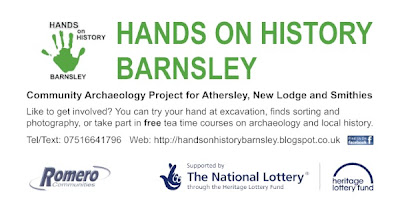Richard Newman School saw the opening up of 9 pits along the
edge of the sports field. The first
group of 50 appeared on the horizon and immediately swarmed down to their pits. With a brief explanation the young community archaeologists got straight to
work reducing the pits in depth and learning and questioning as the went. The enthusiasm was limitless the volunteers
in stunned shock. However after a
revitalising brew with Greek honey we got back to our feet ready for the
afternoon session with another 50 young community archaeologists.
Athersley North School allowed us to dig across a corner of the
field which unfortunately had been recently landscaped and consisted of made
ground of modern building materials. 7
test pits were opened up, but none were completed. However again the enthusiasm was enormous as
was the children’s ambitions to get down to Australia.
Athersley South School was incredible privilege to work at with
facilities laid on and the weather was perfect. Yet again the children were very keen on using all the tools, digging and sieving the spoil. Beryl’s granddaughter Sophie got a real taste for archaeology, clearly a ‘chip of the old block’ (sorry Beryl).
setting out the test pits in the morning
Yet again the children were very keen on using all the tools, digging
and sieving the spoil. Beryl’s granddaughter
Sophie got a real taste for archaeology, clearly a ‘chip of the old block’ (sorry
Beryl).
We had no real
expectations of significant archaeology until during the afternoon Cole turned
up a Georgian piece of jewelry.
Cole's find of the month (TP40)
This
was confirmed by the Portable Antiquities Officer for South
Yorkshire, Ms Eleanor Cox, as a fob seal of late Post-medieval date (AD 1700-1800). Fob seals were used to mark the wax that used to seal envelopes and hung round the writer's neck, and evidences just how aspirational and communicative Athersley folk were during the Late Post Medieval period.
So an exhausting but deeply rewarding time had by all, more anon - Chris Scurfield 2013




















